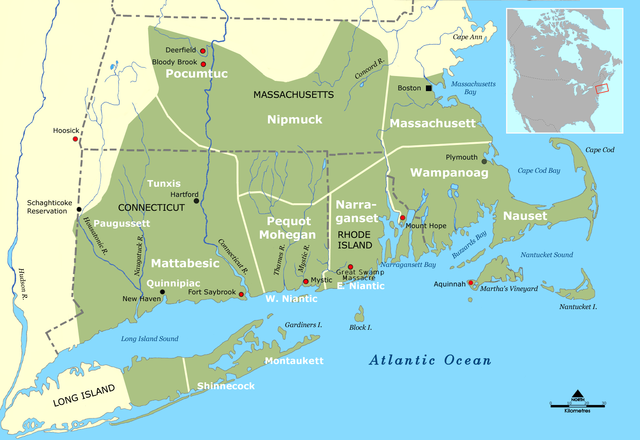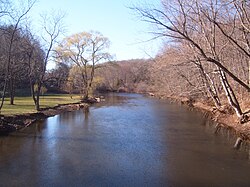Top Qs
Timeline
Chat
Perspective
Quinnipiac
Historic Native American group From Wikipedia, the free encyclopedia
Remove ads
The Quinnipiac were a historical Indigenous people of the Northeastern Woodlands. They lived in present-day New Haven County, Connecticut, along the Quinnipiac River.[2] Their primary village, also called Quinnipiac, was where New Haven, Connecticut is today.[3]
Remove ads
Name
The Quinnipiac name translates as "Long-water people."[4] It was also spelled Quienepiage, Quenepiake, Qunnipiéuk, Qunnipiuck, Qunnipiug, Quinnpiipuck, Quunnipieuck, and Qvinipiak.[5]
Language
The Quinnipiac and several neighboring tribes in central Connecticut and central Long Island all spoke Quiripi, an Eastern Algonquian language. Reverend Abraham Pierson translated the catechism into Quiripi in 1658. Reverend Ezra Stiles and Thomas Jefferson both collected word lists in Quiripi.[6] The language went extinct in the late 19th century.[6]
Political structure
Seventeenth century colonist and writer on Indian tribes Daniel Gookin asserted the Quinnipiac were part of the Pequot;[3] this association is unlikely, given that the Quinnipiac sought military protection from the Pequot and Mohawk in their first treaty with English settlers.[7] 19th-century historian Edward Manning Ruttenber regarded the Quinnipiac as part of the Wappinger confederacy.[4] The Quinnipiac tribal leader was a sachem. The Totoket people were part of the Quinnipiac sachemdom.[8] The Hammonasset were likely also part of the Quinnipiac sachemdom.[9]
History
Summarize
Perspective
17th century

The Puritans established the first Indian Reservation in 1638. Located near New Haven, Connecticut, the reserve was for the Quinnipiac, but only included 1,200 acres, a small portion of their original territory.[10] The reservation's residents, described as "free" Indians, were placed under the authority of an English agent.[10] They were not allowed to sell or abandon that land, and Native peoples from other tribes were not allowed to visit.[10]
From around 1651 to 1669, Reverend Abraham Pierson, a Congregational minister, proselytized the Quinnipiac near Branford, Connecticut.[11] He translated Christian texts into the Quiripi language.[3] Missionization was not very successful, and the tribe showed "a perverse contempt" for the church.[11]
18th century
In 1730, there were an estimated 250 to 300 Quinnipiac.[3] In 1768, some Quinnipiac left their reservation and joined the Tunxi near Farmington, Connecticut.[3] In 1774, only an estimated 38 Quinnipiac survived.[3] They were part of the large Mahican tribe, whose descendants ultimately migrated to Wisconsin with the Stockbridge Munsee Community and Brotherton Indian Community.[1]
Remove ads
References
Sources
External links
Wikiwand - on
Seamless Wikipedia browsing. On steroids.
Remove ads

